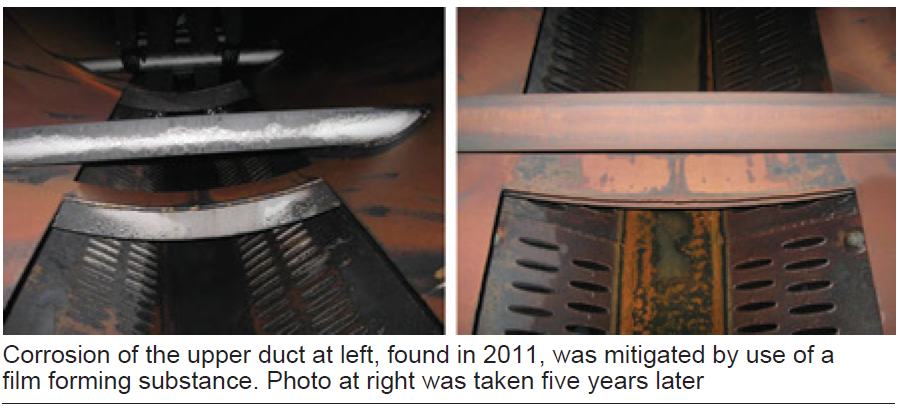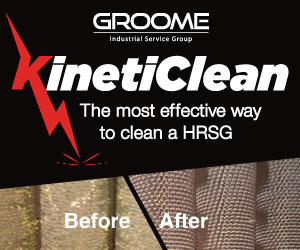The Air-Cooled Condenser Users Group’s 10th annual meeting (October 2018, Colorado Springs) hosted over 100 participants—more than half users, with first-timers in the majority.
The overriding takeaway this year was new information, supported by informative looks into the fundamentals. Such balance expands the benefits of meetings, concludes CCJ Consulting Editor Steve Stultz, who attended the conference for CCJ ONsite. Agenda items covered three categories: equipment design and performance, system operation and maintenance, and the effects of system chemistry.
Chemistry launched the sessions, with Barry Dooley of Structural Integrity Associates Inc, a member of the group’s steering committee chaired by EPRI’s Andy Howell, at the front of the room. He moved quickly into the emerging concerns of air in-leakage and film-forming substances, reminding participants that last year’s event featured a workshop on ACC corrosion mechanisms and detection. This year’s would begin with an overview.
But his synopsis included compelling reminders of chemistry’s impact. “ACCs now are installed at many combined-cycle, conventional, supercritical, and industrial installations,” he stated. “Regardless of system or location,” Dooley stressed, “damage and appearance are almost always the same if system chemistry is not correct.” If anyone should know, it’s Dooley. He has inspected and evaluated the O&M of ACCs in more than 20 countries.
Selected photographic examples of flow-accelerated corrosion, iron, and the strong influence of component geometry confirmed that “material damage and system consequences can be enormous. One example: “If we operate below pH 9.0,” the chemist/metallurgist said, “we will have large amounts of iron coming out of the ACC, leading to critical system failures—including condensate polishers and steam turbines.”
He then reviewed the Dooley Howell ACC Corrosion Index (DHACI), now in widespread use by owner/operators to detect damage and make inter-unit and time-based damage assessments. “There is a one-to-one relationship between equipment damage and the amount of iron in the cycle,” Dooley stated, “and the goal should be to get total iron to less than 10 ppb.”
This led to a discussion on the difficulty of measuring total iron. The best strategy, he pointed out, is contained in Technical Guidance Documents (TGD) issued by the International Association for the Properties of Water and Steam (IAPWS). One in particular is TGD 6-13, “Corrosion-Product Sampling and Analysis for Fossil and Combined-Cycle plants,” which has been endorsed by leading powerplant chemists in more than two-dozen countries. Access www.iapws.org to review and download at no cost all of the organization’s TGDs.
In addition, a valuable guideline for internal inspection of ACCs, he reminded, is ACC.01, available for download at www.acc-usersgroup.org/reports/, also at no cost.
The discussion then turned to film-forming substances (FFS), a topic reportedly triggering some confusion (and misuse) within the industry. Dooley offered the latest definitions from IAPWS: “Film-forming amines ad products (FFA/FFAP) are amine-based. Film-forming products (FFP) are non-amine and the specifics are proprietary—unfortunately for users. All are now called FFS by IAPWS and others.”

“There can be many problems when these substances are not applied properly,” Dooley warned. “Owner/operators must investigate equipment carefully before application to make direct post-application comparison, and must then be monitored carefully.”
The premier standard for these substances is TGD 8-16, “Application of Film-Forming Amines in Fossil, Combined-Cycle, and Biomass Power Plants.” Section 8 of this TGD begins as follows: “This section provides guidance for operators when applying FFA/FFAP to generating plants as a supplement to, or as a replacement for, the current chemistry regime. This is the base case for this IAPWS TGD, and it is applicable to all-ferrous, fossil, combined-cycle/HRSG, and biomass plants.
Discussions followed, with one participant explaining what is perhaps the first use of FSS in a US ACC. Many others are currently investigating uses. Dooley issued a stern warning: “If these substances are not applied properly, deposits can simply go elsewhere and cause extreme damage.”
Chemical suppliers may not know the details. And there are no universal answers. “Each system must be viewed as unique,” he emphasized.
Dooley concluded his portion of the program with an introduction to air in-leakage and common sources of leakage at plants with ACCs—including cracked welds, open valves, leaking flanges, LP-turbine/condenser expansion joints, loose instrument fittings and/or connections, condensate receiver tank joints, and inter-condenser drain-system connections. There are many other sources of leakage as well.




